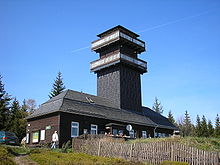Schmiedefeld (Saalfeld)
|
Blacksmith field
District town of Saalfeld / Saale
|
|
|---|---|
| Coordinates: 50 ° 32 ′ 6 ″ N , 11 ° 13 ′ 0 ″ E | |
| Height : | 750 m |
| Area : | 9.54 km² |
| Residents : | 996 (December 31, 2017) |
| Population density : | 104 inhabitants / km² |
| Incorporation : | 1st January 2019 |
| Postal code : | 07318 |
| Area code : | 036701 |
Schmiedefeld is a district of the district town of Saalfeld / Saale in the Saalfeld-Rudolstadt district in Thuringia (Germany).
geography
Schmiedefeld is located in the Thuringian Slate Mountains between the towns of Saalfeld (north) and Sonneberg (south) on the southeastern slope of the 802 meter high Rauhhügel at an altitude of about 700 meters. To the southeast of the village, the landscape continues to drop down into the gorge-like valley of the Geberbach .
history
Schmiedefeld was first mentioned in a document in 1414 and originally belonged to the Counts of Orlamünde . In 1426 the place came to the House of Wettin at the Graefenthal office. From 1826 to 1920 Schmiedefeld belonged to Sachsen-Meiningen ( Saalfeld district ).
In 1898 the place in Taubenbach received a railway connection on the Probstzella – Bock-Wallendorf line , which was later extended to Neuhaus am Rennweg .
In 1920 the state of Thuringia was founded and then subdivided into districts, whereby the place came to the district of Saalfeld .
During the Second World War 110 prisoners of war from Poland and France had to do forced labor : in the iron ore mine and at the roasting furnace .
On July 1, 1950, the previously independent municipality Taubenbach was incorporated.
On July 25, 1952, the community Schmiedefeld was assigned to the Neuhaus district . Since 1994 the place belongs to the district of Saalfeld-Rudolstadt .
The community of Schmiedefeld was incorporated into the district town of Saalfeld / Saale on January 1, 2019, previously it was part of the Lichtetal am Rennsteig administrative community . The community of Schmiedefeld belonged to the Taubenbach district south of the main town .
politics
Municipal council
The council of the community Schmiedefeld consisted of 8 members.
- CDU : 3 seats
- Fire department: 5 seats
mayor
The honorary mayor Ulrich Körner was elected in 2016.
coat of arms
The coat of arms was approved on November 8, 1991. Blazon : "In red a curved golden tip, topped with a black, red-armored lion, which is surrounded by six red hearts, accompanied by four cross-arranged silver nails at the front and a silver spruce tree at the back."
Culture and sights
See the list of cultural monuments in Saalfeld / Saale
- Michaeliskirche
- Herbs and Olities Museum At the poison mixer
- Morassina show mine with the fairytale grotto and the Saint Barbara cave.
- Westfeld open-cast mine with educational mining trail
- Leipzig tower in Schmiedefeld with two viewing platforms
- a 94 meter high reinforced concrete transmission tower built by Deutsche Telekom AG in 1996 ( geographical location )
Economy and Infrastructure
Schmiedefeld was once a settlement of miners, as numerous different ores ( iron , copper , gold ) could be mined here . Iron ore has been mined since 1663. The iron ore mine was acquired by Maximilianshütte Sulzbach-Rosenberg in 1888 . From 1948 onwards the company was nationalized and renamed VEB Eisenerz / Maximilianshütte Unterwellenborn . It closed in 1972. The VEB ISOKO Schmiedefeld , which emerged from the ironworks of the ore mine in Schmiedefeld in 1974, produced the QEK Junior caravans, which were delivered on the rail route of the Probstzella – Neuhaus railway on Rennweg . After Schmiedefeld - as in the entire slate mountains - the glass industry with the VEB foam glass factory Taubenbach was added as a new line of business. Today the place lives mainly from various small industries and tourism.
Transport links
Schmiedefeld is on the federal road 281 , which leads from Eisfeld and Neuhaus am Rennweg to Saalfeld . Between 1898 and 1998 the place had a railway connection on the Probstzella – Neuhaus am Rennweg with the train station in the Taubenbach district.
Individual evidence
- ↑ Thuringian Association of the Persecuted of the Nazi Regime - Association of Antifascists and Study Group of German Resistance 1933–1945 (Ed.): Local history guide to sites of resistance and persecution 1933–1945. Volume 8: Thuringia. VAS - Verlag für Akademische Schriften, Frankfurt am Main 2003, ISBN 3-88864-343-0 , p. 244.
- ↑ Eckart Roloff , Karin Henke-Wendt: Schmiedefeld (Lichtetal), herb and oil museum "At the poison mixer". In: Eckart Roloff, Karin Henke-Wendt: Visit your doctor or pharmacist. A tour through Germany's museums for medicine and pharmacy. Volume 2: Southern Germany. S. Hirzel, Stuttgart 2015, ISBN 978-3-7776-2511-9 , pp. 232-233.
- ^ Albert Gieseler: Schmiedefeld mine. Retrieved November 19, 2019 .

